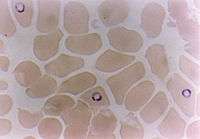Romanowsky stain
Romanowsky staining is a prototypical staining technique that was the forerunner of several distinct but similar methods, including Giemsa, Jenner, Wright, Field, and Leishman stains, which are used to differentiate cells in pathologic specimens. It was named after the Russian physician Dmitri Leonidovich Romanowsky (1861–1921), who invented it in 1891.
Microscopic examination of stained blood films

Paul Ehrlich had used mixtures of acidic and basic dyes for this purpose in 1879: e.g. fuchsine (acid dye) and methylene blue (basic dye).[2] In 1891, Romanowsky[3][4][5] developed techniques using a mixture of eosin Y and modified methylene blue that produced a surprising hue unattributable to either staining component: a beautiful, distinctive shade of purple.[6][7] Requirement for the occurrence of the Romanowsky-Giemsa effect are:
- A cationic dye: The best dye is azure B and, though azure A gives the nuclear purple colour, the cytoplasmic blue is inferior. No other cationic dye such as methylene blue is suitable.
- An anionic dye: Most commonly eosin Y is used.[8]
Because the aqueous dye solutions were unstable, methanol was introduced as a solvent, and William Boog Leishman [9] and James Homer Wright[10] advocated its use as a fixative prior to staining. Gustav Giemsa improved this technique by standardizing the dye solutions and adding glycerol to increase stability.[11]
The demethylation of methylene blue in aqueous solution using heat and alkali produces a mixture of azure A, azure B, methylene violet, and methylene blue. Eosin Y is then added to produce a "neutral" dye. The precipitate is then dissolved in a mixture of methanol and glycerol to form a stock solution; this is diluted with water or an aqueous buffer to form a 'working' solution that is used in the staining of pathology specimens. The 'working' solution is stable for 3 hours.[12]
Immunochromatographic capture procedures (rapid diagnostic tests such as the malaria antigen detection tests) are nonmicroscopic diagnostic options for the laboratory that may not have appropriate microscopy expertise available.[13]
See also
References
- ↑ Hempelmann E, Tesarowicz I, Oleksyn BJ (2008). "Malaria wciąż groźna". Wszechświat. 109: 180–189.
- ↑ Ehrlich P (1880). "Methodologische Beiträge zur Physiologie und Pathologie der verschiedenen Formen der Leukocyten" (PDF). Z klin Med. 1: 553–560.
- ↑ Романовскiй Д.Л. (1890). "Къ вопросу о строенiи чужеядныхъ малярiи". Врачъ. 52: 1171–1173.
- ↑ Романовскiй Д.Л. Къ вопросу о паразитологiи и терапiи болотной лихорадки. Диссертацiя на степень доктора медицины. Спб. 1891 г., 118 с.
- ↑ Romanowsky D (1891). "Zur Frage der Parasitologie und Therapie der Malaria". St Petersburg Med Wochenschr. 16: 297–302, 307–315.
- ↑ Horobin RW, Walter KJ (1987). "Understanding Romanowsky staining. I: The Romanowsky-Giemsa effect in blood smears". Histochemistry. 86 (3): 331–336. PMID 2437082. doi:10.1007/bf00490267.
- ↑ Woronzoff-Dashkoff KK. (2002). "The wright-giemsa stain. Secrets revealed". Clin Lab Med. 22 (1): 15–23. PMID 11933573. doi:10.1016/S0272-2712(03)00065-9.
- ↑ Wittekind D (1979). "On the nature of Romanowsky dyes and the Romanowsky-Giemsa effect". Clin Lab Haematol. 1 (4): 247–262. PMID 94558. doi:10.1111/j.1365-2257.1979.tb01090.x.
- ↑ Leishman W (1901). "Note on a Simple and Rapid Method of Producing Romanowsky Staining in Malarial and other Blood Films". Br Med J. 2 (2125): 757–758. PMC 2507168
 . PMID 20759810. doi:10.1136/bmj.2.2125.757.
. PMID 20759810. doi:10.1136/bmj.2.2125.757. - ↑ Wright JH (1902). "A Rapid Method for the Differential Staining of Blood Films and Malarial Parasites". J Med Res. 7 (1): 138–144. PMC 2105822
 . PMID 19971449.
. PMID 19971449. - ↑ Giemsa G (1904). "Eine Vereinfachung und Vervollkommnung meiner Methylenazur-Methylenblau-Eosin-Färbemethode zur Erzielung der Romanowsky-Nochtschen Chromatinfärbung". Centralbl f Bakt etc. 37: 308–311.
- ↑ Marshall PN, Bentley SA, Lewis SM (1978). "Staining properties and stability of a standardised Romanowsky stain". J Clin Pathol. 31 (3): 280–282. PMC 1145244
 . PMID 76638. doi:10.1136/jcp.31.3.280.
. PMID 76638. doi:10.1136/jcp.31.3.280. - ↑ Hempelmann E, Wilson RJ (1982). "Immunoprecipitation of malarial enzymes". Protozoology. 29: 637.
- Further reading
External links
- Diagnosis and Treatment of Malaria CDC website on malaria diagnosis and treatment
- Field stain Staining methods for the identification of malaria parasites
- Laboratory Diagnosis of Malaria This Royal Perth Hospital (Australia) website provides an excellent overview of malaria diagnostics
- UK malaria advisory, diagnostic and reference service for malaria The Malaria Reference Laboratory of the Public Health Laboratory Service in the UK
- Chenzinsky and Romanowsky(in Russian)(in English) On the 120th Anniversary of the Discovery of the Romanowsky Effect